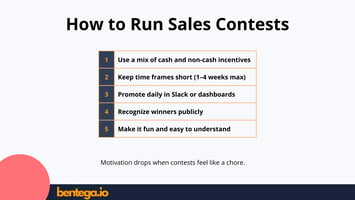How to Measure the Success of a SPIF Program
SPIFs (Sales Performance Incentive Funds) are powerful tools to motivate behavior and drive short-term sales outcomes. But to justify continued investment - and iterate on what works - you need a clear way to measure SPIF success and prove SPIF ROI.
If you’re still finalising your incentives and rules, start with our SPIF fundamentals guide and then apply the measurement framework in this article.
In this guide, we’ll walk through the essential metrics, tools, and best practices for tracking the impact of your SPIF program or sales contest, so you can confidently report results and improve outcomes.
Why Measuring SPIF Success Matters
It’s easy to assume that if revenue ticks up during a SPIF, the program worked. But without structured measurement, you could miss:
-
Whether the lift was incremental or cannibalized
-
If the cost outweighed the reward
-
Which reps truly changed behavior
-
How sustainable the results were
Clear measurement gives you proof, not just gut feel.
Define Success: What Are You Trying to Achieve?
Before you can measure, define the desired outcome. Common SPIF goals include:
-
Increased sales volume
-
Higher attach rates or upsell volume
-
More qualified meetings booked
-
Improved CRM data quality
-
Faster deal velocity
-
Penetration into new verticals
Pro tip: Tie your goal to one clear metric per SPIF.
1. Track the Right KPIs Before, During, and After
A solid SPIF ROI calculation starts with the right data. Here are key performance indicators (KPIs) to monitor:
| Metric | Why It Matters |
|---|---|
| Revenue Uplift | Measures actual sales impact |
| Incremental Sales | Filters out sales that would have happened anyway |
| Participation Rate | Shows how many reps engaged |
| Goal Attainment | % of reps who hit SPIF targets |
| Cost Per Deal | Compares bonus payout to closed revenue |
| Activity Metrics | Calls, meetings, emails - shows behavior change |
| Payout Total | Overall spend on the SPIF program |
2. Calculate SPIF ROI the Right Way
There’s no universal formula, but here’s a basic ROI calculation in sales contexts:
SPIF ROI = (Incremental Revenue – Cost of Incentives) / Cost of Incentives
Let’s say:
-
Revenue during SPIF = $150,000
-
Expected revenue without SPIF = $100,000
-
Total SPIF cost = $15,000
Incremental Revenue = $50,000
SPIF ROI = ($50,000 – $15,000) / $15,000 = 2.33 → 233% ROI
3. Segment the Data by Rep, Region, and Product
To understand what actually worked, break down your results:
-
Who performed best?
-
Which product line got the most lift?
-
Did some teams or geographies respond better?
Segmentation helps you fine-tune future SPIF programs and allocate incentive budgets more effectively.
4. Measure Sales Contest Success Over Time
For sales contests or gamified SPIFs, track outcomes beyond the end date:
-
Did top performers sustain momentum?
-
Did deal quality drop during the contest?
-
Did non-winners disengage?
Also consider team morale and sales motivation as softer success signals.
5. Collect Feedback from Sales Reps
Data tells you what happened. Reps tell you why.
Use surveys or post-SPIF retros to ask:
-
Was the SPIF easy to understand?
-
Was the reward motivating?
-
Did the rules feel fair?
-
Would you want to participate again?
This qualitative insight is key to future SPIF success.
6. Use Technology to Automate Tracking
Manual tracking limits visibility. Tools like Bentega let you:
-
Set measurable goals
-
Track rep progress in real time
-
Automate bonus calculations
-
Visualize SPIF ROI
-
Run multiple incentive types in parallel
Modern platforms make SPIFs easier to manage and measure.
7. Benchmark and Compare Over Time
Don’t treat each SPIF in isolation. Build a performance history:
-
Average ROI across all SPIFs
-
Which themes or formats perform best
-
Cost per unit of lift (revenue, meetings, new customers)
Benchmarking helps you identify what success looks like in your organization and scale winning tactics.
Final Thoughts: Data-Driven SPIF Optimization
A SPIF without measurement is just a gamble.
But with the right KPIs, ROI analysis, and post-program insight, you can turn every SPIF or sales competition into a repeatable growth lever.
Treat every SPIF as an experiment. Track results. Improve over time. That’s how you unlock SPIF success at scale.
Related Articles
- SPIF Guide
- When and How to Use SPIF
- SPIF Meaning: Everything You Need to Know
- How to Structure a High-Impact Sales SPIF Program
- Cash vs. Non-Cash SPIF Incentives: Which Works Better?
- Common SPIF Mistakes and How to Avoid Them: High-Impact Incentives
- Top Sales SPIF Examples That Drive Real Performance
📈 Ready to Optimize SPIF ROI?
At Bentega, we help you design, automate, and measure high-performance SPIF programs - so every sales incentive drives ROI you can actually track. Visit www.bentega.io today!


